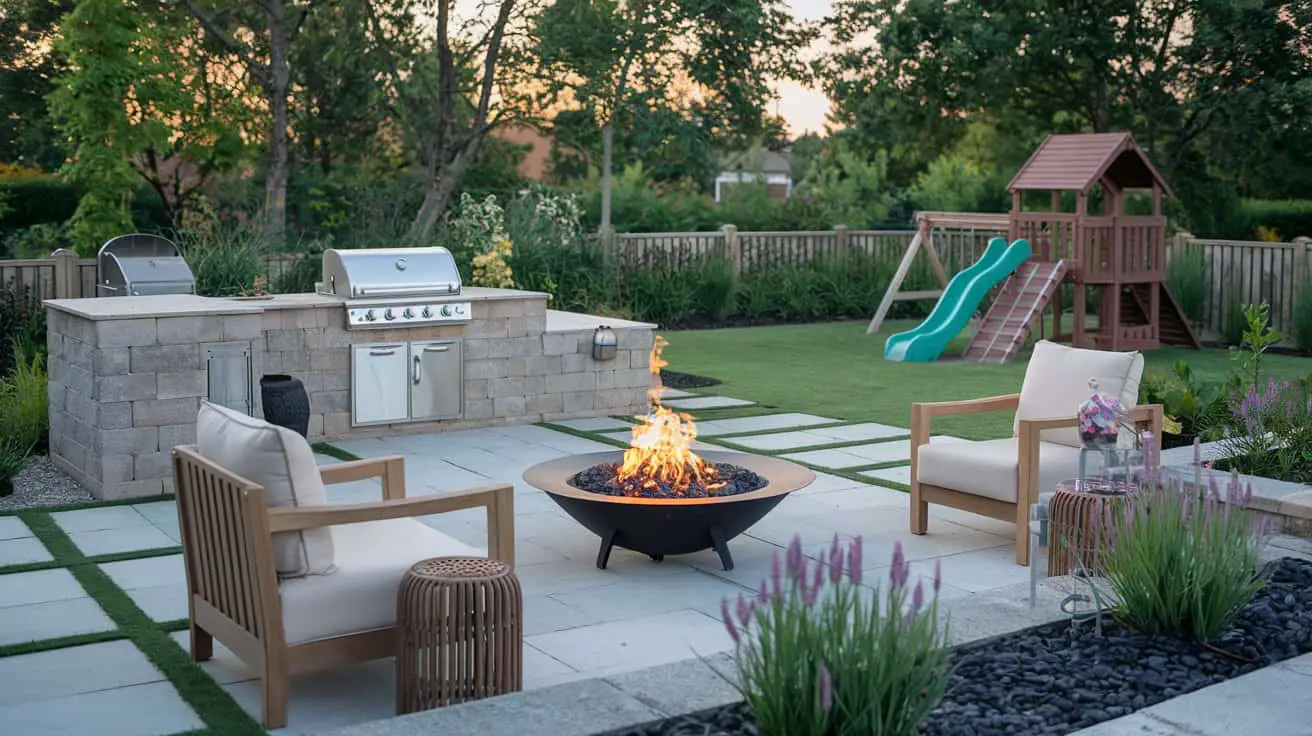
Designing a family garden sounds easy at first. You just need a lawn for the kids, a patio for the grown-ups, and maybe a few flowers for decoration, right? But anyone who’s actually tried it knows that getting the balance right is far trickier than it seems.
One moment, you’re dreaming of a stylish, modern outdoor retreat; the next, you’re knee-deep in Pinterest boards wondering if it’s possible to have a beautiful backyard that isn’t overrun with abandoned scooters, half-deflated footballs, a broken BBQ and a sandpit that looks like a cat’s personal restroom.
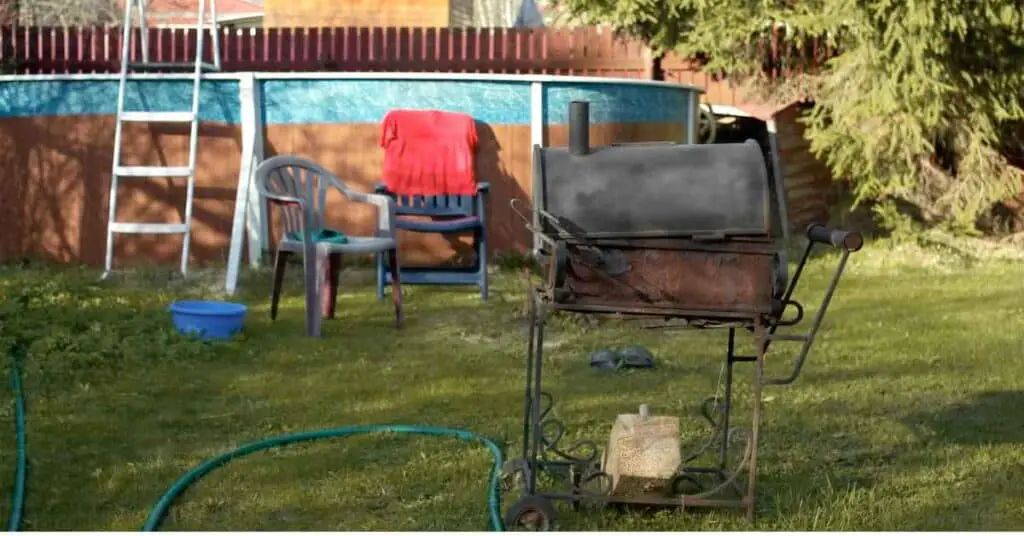
The truth is, most gardens end up catering too much to one group. Some are pristine, architectural masterpieces that look stunning but feel about as welcoming to kids as a museum full of “Do Not Touch” signs. Others are completely taken over by slides, swings, and plastic toys—leaving no space for adults to actually sit and enjoy it.
A great family garden, however, finds that perfect balance between fun and functionality—somewhere between an adventure playground and a peaceful retreat.
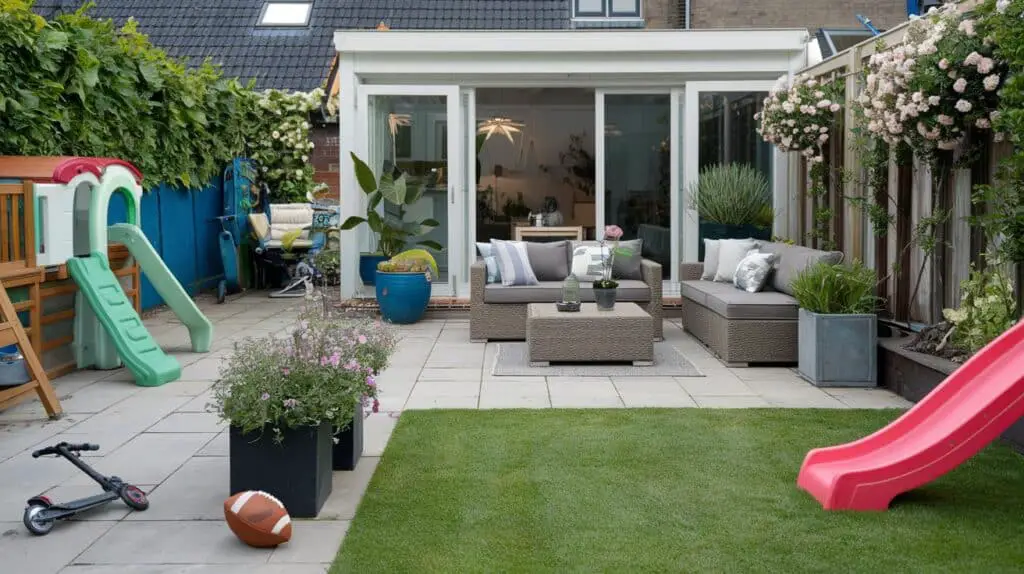
When I first attempted to design a family-friendly garden, I made one crucial mistake: I designed it for my child at that exact stage of life. It was perfect for a toddler—soft grass, a little playhouse, and raised flower beds they could dig in. Fast-forward two years, and suddenly, my neatly arranged garden was under siege.
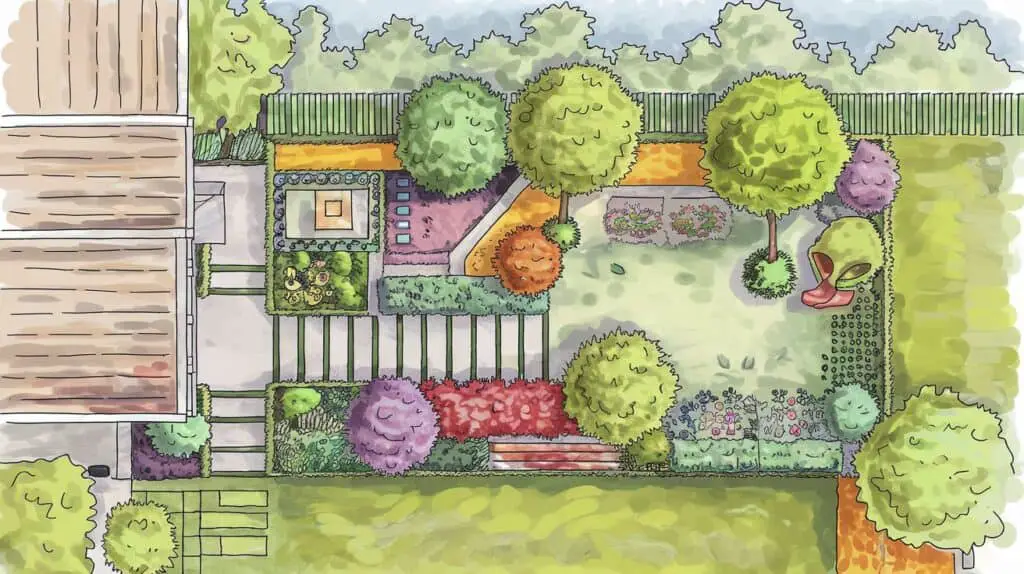
The playhouse was abandoned in favor of a bike ramp (not designed for a bike ramp), and the raised beds? Now makeshift goalposts. If I’d thought a little further ahead, I would have realized that family gardens aren’t just about creating spaces for kids now—they need to evolve as your family grows.
That’s the secret to good family garden design: flexibility. A space that works when your kids are small but doesn’t become obsolete as they grow. A garden that allows for play but doesn’t sacrifice style.

A space that gives everyone—kids, parents, even the dog—somewhere to enjoy. And let’s not forget a design that doesn’t become a maintenance nightmare, because who really wants to spend every weekend trimming hedges and scrubbing moss off a patio?
The challenge is knowing how to pull it all together. Where do you put play areas so they don’t dominate the whole garden? How do you make sure children actually want to spend time outside?
What materials should you use that can withstand both muddy boots and summer BBQs? And most importantly, how do you create a space that feels like yours—not just a chaotic extension of the kids’ toy box?
That’s exactly what this guide is here for. We’ll walk through the best layouts for large family gardens, clever landscaping tricks, how to avoid common design mistakes, and ways to make your garden practical yet beautiful.
Whether you have a large backyard, a modern garden, or a flat open space in need of structure, you’ll find ideas here to create a space that’s as stylish as it is family-friendly.
Because a garden should be more than just somewhere to store outdoor toys—it should be a place where everyone, of every age, actually wants to spend time.
What Makes a Garden Truly Family-Friendly?

A family-friendly garden isn’t just about cramming in a swing set and hoping for the best. It’s about creating a space where everyone—kids, parents, and even pets—feels welcome and comfortable. The best family gardens strike the perfect balance between practicality, beauty, and fun, making sure the space is not only safe and engaging for children but also relaxing and enjoyable for adults.
One of the biggest mistakes I made in my first garden was focusing too much on aesthetics and forgetting usability. I planted delicate flowers that looked amazing but wilted at the first sign of a football. I laid down a pristine white gravel path that, within weeks, was more of a pebble pit where my child liked to “excavate dinosaur bones.” Lesson learned: a family garden needs to be designed for real life, not just Instagram.
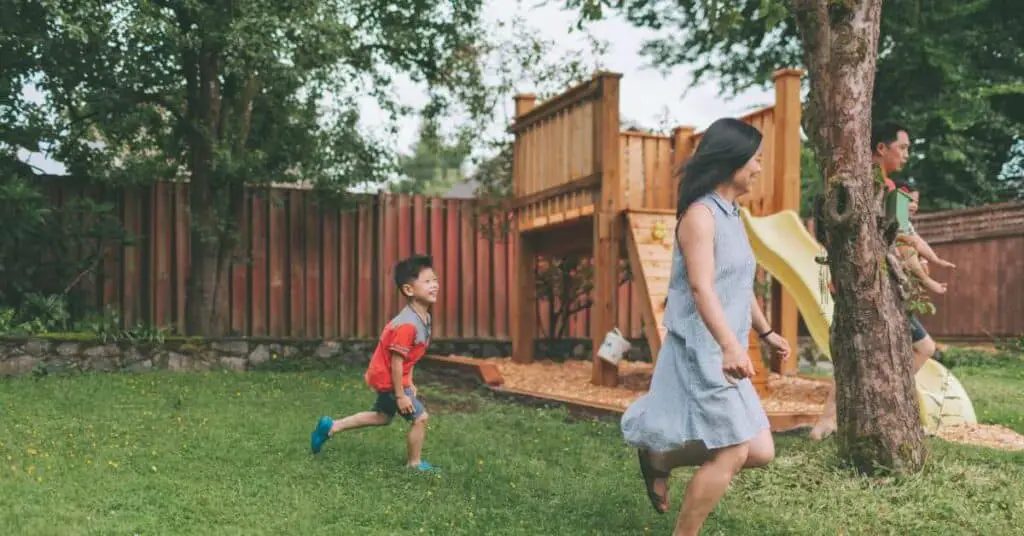
A good family garden doesn’t assign a single function to every space. Instead, it allows areas to serve multiple purposes. A lawn, for example, can be a play area for kids, a picnic spot for weekend lunches, and a laid-back seating area for evening relaxation.
Instead of dedicating half your garden to a huge playground, consider incorporating elements that blend in with the space—like a built-in climbing wall on a garden wall, stepping stones that double as a play path, or a low hedge maze that looks beautiful but also provides fun exploration for kids.

The layout of your garden should allow both kids and adults to enjoy it simultaneously—without stepping on each other’s toes. If play areas are placed too close to seating areas, expect to spend every outdoor dinner dodging flying balls. Instead, consider zoning your garden.
A quiet retreat or seating area for adults, an open space for kids to run and play, and a flexible multi-use space, like a patio or deck, that can work for everything from outdoor dining to family games. By subtly separating spaces, the garden remains usable for both adults and children without feeling like one dominates the other.
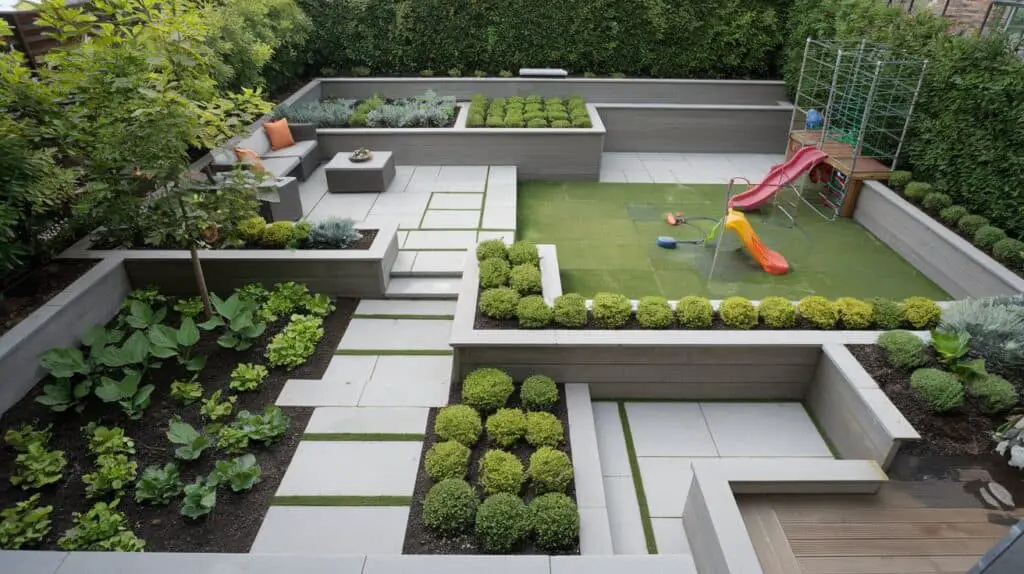
With busy families we don’t have time to spend hours weeding flower beds or replacing broken garden furniture. Using durable materials is key to keeping a family garden looking good with minimal effort.
A few smart choices include brick pathways or patios, which hold up better than gravel or wood decking. Tough, non-toxic plants that can survive the occasional football, such as lavender, rosemary, and ornamental grasses. Weather-resistant furniture that doesn’t need to be stored every time it rains.
Kids’ needs change fast, and the last thing you want is to design a garden that becomes outdated in a few years. Instead of committing to a huge playset that will be ignored by the time your kids turn ten, think about play features that can be adapted over time.

A simple wooden frame that can start as a climbing frame for younger kids and later be turned into a garden trellis. A sandpit with a removable cover, so it can become a firepit or seating area when the kids outgrow it. Flexible furniture, like outdoor beanbags and benches, that work for both kids’ playdates and adult gatherings.
It’s easy to assume that kids will love playing outside, but if the garden isn’t inviting, they’ll retreat back indoors to screens and toys. A family-friendly garden should encourage exploration, creativity, and movement, with features like a mix of textures such as grass, gravel, and stepping stones to make the garden feel interactive.
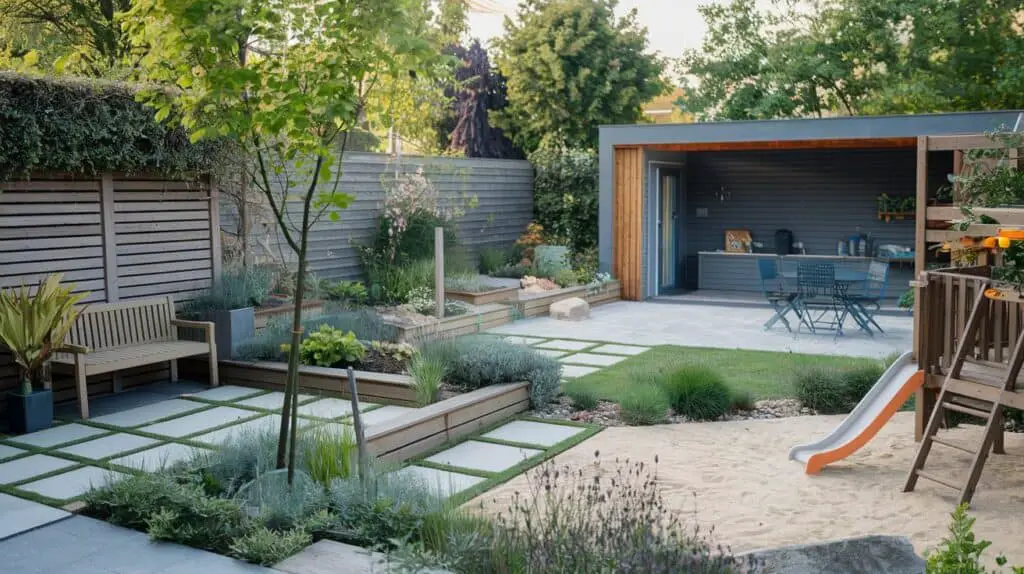
Small “hidden” areas like a den under a tree or a tunnel in a hedge—kids love a sense of adventure. Sensory plants like lavender and mint that they can touch and smell.
A truly family-friendly garden isn’t just about adding kid-friendly features—it’s about designing a space that works for everyone, evolves over time, and doesn’t create unnecessary maintenance headaches. Whether your family loves entertaining, playing, or simply relaxing outdoors, the right layout and materials can transform any garden into a welcoming, practical, and beautiful space that stands the test of time.
Designing a Garden That Grows with Your Family
A family garden should evolve with time, not feel outdated in just a few years. One of the biggest mistakes people make is designing a garden based purely on their current needs. What works for toddlers—like enclosed play areas and soft surfaces—might feel restrictive when they’re older and want space to run, kick a ball, or hang out with friends.
The key is flexibility. Instead of dedicating permanent areas to specific activities, choose adaptable features. A grassy lawn can be a toddler’s crawling space now and a football pitch later. A simple wooden frame might start as a climbing structure but later support hanging chairs or garden lighting. Even a raised garden bed used for sensory play in early years can turn into a real vegetable-growing area when kids are old enough to help in the garden.
Hardscaping choices should also grow with your family. A large patio or deck gives space for ride-on toys now, but in the future, it becomes the perfect spot for summer BBQs and outdoor dining. Built-in seating with storage can hold outdoor toys when kids are small, then transition into a stylish entertaining area.
Thinking ahead saves time, money, and effort down the line. A well-planned garden won’t need a full redesign every few years—it will naturally adapt to your family’s changing lifestyle while still looking beautiful and feeling welcoming for everyone.
The Best Layouts for Large Family Gardens
A big garden might seem like a dream, but without good planning, it can quickly become overwhelming or underused. The trick to making a large family garden work is zoning—creating different areas with distinct purposes while keeping the space feeling cohesive.
Start by dividing your garden into functional zones. A central open space, like a lawn, provides room for kids to run, play sports, or host family picnics. A separate relaxation zone, tucked away with comfortable seating, ensures adults have a peaceful retreat. A patio or decked area near the house can double as an outdoor dining and socializing space, while the more distant corners of the garden can be used for vegetable beds, a wildlife-friendly zone, or even a hidden den for kids.
Pathways and natural borders like hedges, flower beds, or different ground materials help subtly separate each area without making the garden feel chopped up. Avoid placing play areas right next to seating areas—otherwise, every peaceful afternoon tea will be interrupted by a football flying past your head.
The key to designing a great large family garden is making sure every zone has a purpose but still feels connected. That way, it’s not just an expanse of empty lawn but a carefully planned space where every family member has something to enjoy.
Blending Modern and Natural Elements in a Family Garden
A family garden needs to be practical, but that doesn’t mean sacrificing style. The best designs blend modern landscaping with natural elements, creating a space that looks stunning while still being functional for everyday family life.
One way to achieve this is by combining clean lines and structured features with softer, organic elements. A modern farm garden, for example, pairs neatly arranged vegetable beds and sleek stone pathways with wildflower borders and rustic wooden furniture. A brick-paved patio adds durability and a timeless look, while surrounding it with layered greenery prevents it from feeling too harsh.
For families, lodge landscaping ideas work well—using natural materials like wood, stone, and native plants to create a cozy, low-maintenance space. A gravel seating area with a fire pit offers a relaxed gathering spot, while large stepping stones set in grass keep pathways feeling informal yet stylish.
The key is to avoid an overly rigid design. While modern landscaping often leans towards structured symmetry, a family garden benefits from a mix of textures, levels, and natural shapes to keep it inviting and child-friendly.
How to Include Play Areas Without Losing the Garden’s Style
It’s easy to let a garden become overrun with plastic play equipment, but the best family gardens integrate play areas subtly into the design. Rather than dedicating half the garden to a brightly colored swing set, consider features that blend in naturally while still providing fun for kids.
A wooden climbing frame can double as a pergola when kids outgrow it. Sunken trampolines are safer and less visually intrusive than traditional models. A hidden den among trees or bushes offers adventure without dominating the space. Even stepping logs, low walls, or a winding path can add playful elements while maintaining a stylish aesthetic.
Positioning is just as important as design. Keeping play features off to the side or partially enclosed by plants ensures they don’t overwhelm the garden, while choosing natural materials like wood and stone helps them blend into the surroundings. That way, the garden remains a relaxing retreat for adults without feeling like a children’s theme park.
What to Avoid When Designing a Family Garden
It’s easy to focus on what to include in a family garden, but just as important is knowing what not to do. Some design choices seem great in theory but can make your garden less practical, less enjoyable, or even a total hassle to maintain.
One common mistake is overcomplicating the layout. It’s tempting to add too many different elements—winding paths, separate flower beds, raised areas—but too much division makes a garden feel cluttered rather than inviting. Large gardens especially need open spaces to balance out structured areas, ensuring it feels spacious rather than cramped with different zones.
Another issue is high-maintenance features. A garden should be enjoyed, not become another never-ending list of chores. Avoid fragile plants that need constant care, fussy water features that clog easily, and pristine lawns that require weekly mowing to stay looking good. Instead, opt for low-maintenance greenery, sturdy hardscaping, and furniture that can withstand family life without constant upkeep.
One of the biggest mistakes? Designing purely for looks without considering how the space will actually be used. A perfectly styled seating area that never gets used is wasted space, just like a big lawn with no shade might be too hot for kids to play on in summer. A great family garden is not just beautiful—it’s practical, adaptable, and inviting for real everyday use.
Making the Most of a Large, Flat Backyard
A large, flat backyard has plenty of potential, but without smart design, it can feel empty and uninspired. Instead of treating it as one big open space, the trick is to create variety—adding structure, layers, and focal points to make the garden more interesting and usable.
One way to break up a large, flat area is by using different ground materials. A mix of lawn, gravel, decking, and paved paths creates visual interest while defining separate zones. Adding height also makes a difference—raised flower beds, pergolas, or a slightly elevated seating area can transform a plain backyard into something dynamic.
Think about how different parts of the garden will be used. A dedicated play space for kids, a social area with a fire pit or BBQ, and a relaxing retreat tucked into a corner with benches or hammocks all help make the space feel purposeful.
Avoid placing everything at the edges, which can make the middle of the garden feel like a vast, empty void. Instead, use central features like a garden path leading to a focal point (a tree, a water feature, or a seating area) to draw the eye through the space and make it feel more inviting. A large backyard is a luxury, but thoughtful design ensures every part of it is used and enjoyed.
The Role of Hardscaping in Family Garden Design
Hardscaping is the backbone of a well-designed family garden. While plants and lawn areas bring life to the space, patios, pathways, walls, and other built structures provide functionality, durability, and year-round usability. Without good hardscaping, gardens can feel either too empty or too chaotic—especially when kids are involved.
One of the best choices for family gardens is brick or stone patios, which are far more durable than decking or gravel, both of which need regular upkeep. A well-placed patio can serve as an outdoor dining area, a play space, or even a future spot for a fire pit as your family grows. Wide, sturdy pathways also make a difference—kids will naturally run and cycle along them, so choosing solid, non-slip materials ensures they hold up over time.
Built-in seating is another great addition. Instead of cluttering your garden with movable chairs that constantly get rearranged (or knocked over), integrated benches made from stone or wood provide low-maintenance, stylish, and functional seating that blends seamlessly into the space.
The key to using hardscaping well is balance. Too much and the garden can feel cold and uninviting, like a courtyard. Too little and it becomes impractical, especially in wet weather. The best family gardens strike a middle ground—using hardscaping to add structure while keeping plenty of green space for relaxation and play.
Choosing Plants and Features That Suit a Family Lifestyle
When designing a family garden, plant choice matters more than you’d think. Some plants are beautiful but fragile. Others are hardy but high-maintenance. And some—like anything with thorns, toxic leaves, or delicate flowers—are best avoided altogether if you want your garden to be both safe and easy to manage.
For a low-maintenance family garden, opt for plants that can handle a bit of rough treatment. Lavender, rosemary, ornamental grasses, and hardy perennials all survive being trampled by running feet (or the occasional rogue football). Wildflowers and native plants are another great option—they attract pollinators, need minimal care, and bring a burst of color.
Avoid anything that requires constant pruning, special soil conditions, or excessive watering. The last thing you want is a garden that needs more care than you have time for. Also, consider adding tactile, sensory plants that make the space more interactive—kids love running their hands through soft grasses or smelling fragrant herbs.
In terms of features, a water element can add relaxation for adults, but make sure it’s safe for kids. Raised beds provide a controlled way to introduce gardening without worrying about kids digging up your flower borders. And if you love entertaining, a simple fire pit or outdoor kitchen area turns your garden into a space that brings the whole family together.
The Social Aspect: Creating Spaces for Gatherings and Relaxation
A family garden isn’t just for play—it’s also a place for relaxation, connection, and socializing. Whether it’s hosting BBQs, family dinners, or simply unwinding after a long day, the right design can make your outdoor space feel like an extension of your home.
A dedicated outdoor seating area is essential, but think beyond just a standard patio set. Built-in benches, outdoor sofas with weather-resistant cushions, or even a hammock corner all help create a space where people want to linger. If you entertain often, a BBQ area or outdoor bar can make family gatherings even more enjoyable.
Lighting also plays a huge role in making a garden feel inviting in the evenings. String lights, solar lanterns, or discreet path lighting can transform a daytime play space into a cozy nighttime retreat.
If your family loves being outside but struggles to find time, making the seating area comfortable and practical (with shade in summer and warmth in cooler months) encourages everyone to use it more often.
Sustainability in a Family Garden: Low-Maintenance and Eco-Friendly Ideas
Sustainable gardens aren’t just better for the environment—they’re also easier to maintain. Choosing low-maintenance, drought-resistant plants reduces the need for constant watering, while mulching garden beds helps retain moisture and suppress weeds.
If you have space, a wildlife-friendly area can be a fantastic addition. Allowing part of your garden to grow more naturally—with wildflowers, log piles, or a small pond—creates a habitat for birds, bees, and butterflies. Even a simple bug hotel or bird feeder can turn your garden into an interactive learning space for kids.
Water conservation is another key consideration. Rainwater collection barrels help keep your plants hydrated without increasing your water bill, and permeable paving prevents flooding and runoff. If you love growing food, even a small raised bed or potted herb garden can be a great way to introduce sustainability into your outdoor space.
By making eco-friendly choices, you create a garden that is not only beautiful but also practical, cost-effective, and built to last.
Final Tips for Achieving a Beautiful Yet Functional Family Garden
Bringing everything together, the best family gardens are those that strike the perfect balance between style, function, and adaptability. They provide enough structure to look elegant, enough space to be practical, and enough flexibility to grow with your family over the years.
Some final things to keep in mind:
• Prioritize durability—choose materials and plants that can withstand family life.
• Think long-term—design your garden so that it remains functional as your kids grow.
• Make sure every part of the garden has a purpose—whether for play, relaxation, or entertaining.
• Avoid overcomplicating the design—simplicity often leads to the most enjoyable, usable spaces.
• Use natural elements to soften hardscaping—a mix of textures keeps the garden feeling warm and inviting.
A well-designed family garden isn’t just a place to look at—it’s a space to live in. Whether you want an elegant yet child-friendly backyard, a low-maintenance outdoor retreat, or a garden that evolves as your family does, a thoughtful approach ensures your outdoor space is loved for years to come.
